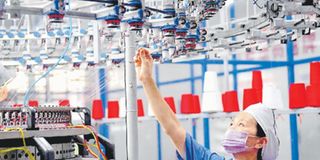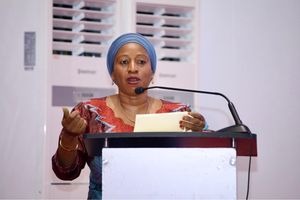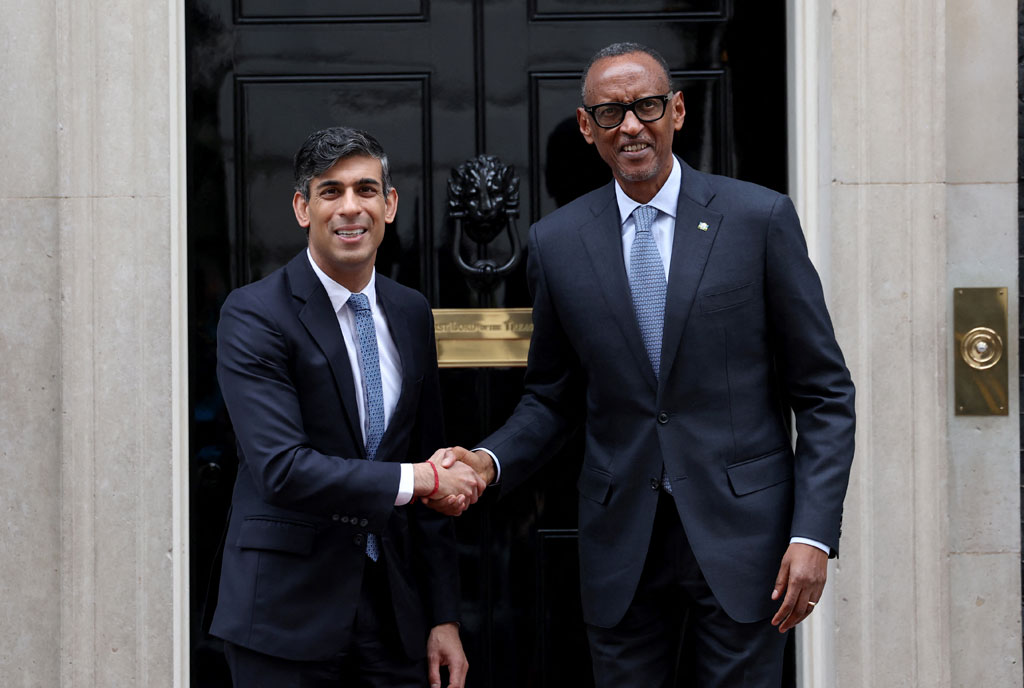China: Two stories and the fortune of nations

This file picture taken on September 8, 2018 shows an employee monitoring a circular weaving machine at a textile factory in Shangqiu in China's central Henan province.
What you need to know:
Sometimes, human connections are what we need to become and remain humble amidst our ignorance and thirsty in our search for knowledge
It is 10pm, and the train grinds to a full stop at Qingdao, an industrial town by the Yellow Sea, located 700 kilometers south of Beijing. I am here to add to my understanding of China, a factor, or variable - whatever you want to call it – on how and where humanity will move in this century.
The train doors open, and a cold gush sweeps inside our cabin with similar effect as when you open a freezer. As I emerge out of the station, I’m met by my host, Mr Wenli Du, a quiet and understated gentleman in his late 50s. Though already an acquaintance, calling him Mr Du appears perfect. I came here to speak to him because I believe that what he does and how he does it may tell a small but important part of the story of China – and how that story, depending on how it unfolds, will shape the fortunes of nations.
Mr Du takes the wheel and we drive to the hotel. The dancing and flickering light decorations draping the skyscrapers and landscaping along the road give a festive air. I ask Mr Du if there is any special occasion. He says no, adding that this is just a simple and cheaper way of making the city look nice, lively and safe at night.
Next morning, Mr Du comes to pick me up and we drive to his factory in Tieshan Industrial Park. I had decided and communicated to my hosts that my visit is informal, quiet and exploratory. But the Chinese, out of sense of respect and tradition, do not receive visitors quietly and informally. So, I found a welcome banner and a receiving delegation.
Mr Du’s factory is special. Because it is a factory of factories: he manufactures equipment and machinery needed to set up factories. He has a set of four buildings, one of them with the size of a football pitch. We walk into one building, and I see groups of new machinery and only two people working. Used to seeing hundreds of people on factory floors, I ask him why his people are not working today. He looks at me puzzled. “This IS everyone”, he says. Why? Because almost every process here is fully automated through robotics and artificial intelligence (AI). In this entire factory of factories, I could count about 12 people on floors full of machines and equipment for sets of factories ready to be shipped out.
New China
This is the new China, no longer the “world’s factory” but the “world’s factories factory”. The move from basic to advanced manufacturing is a natural progression, but it is happening so fast in China. The government here reckons that the future of global security and commerce will be shaped by AI and China’s leaders have decided that they will decisively lead it. From 2017, they have been leading in AI investments and research output. And in all AI patents filed globally last year, China was number one (significantly, this also speaks of the movement from “copying” technology to protecting private intellectual property).
The unmanned machines, humming and moving arms, in this cold factory floor speak of the tremendous opportunities (where industrial productivity will be optimal) and perils (where human labour, and its purpose, will have to be rethought and reshaped) in this new era.
Mr Du, clearly not in reflective mode, is pacing ahead of me.
After the factory walkabout, we talk about the future of manufacturing and the challenges in selling and servicing machinery around the world. Mr Du’s main expertise is rubber and tyre manufacturing machinery. He shows me the map where he has sold his machines – Yemen, Egypt, Bangladesh, Ivory Coast, really all over the place. I ask about Tanzania. He tells me (what I know already) that we import all tyres – for toy bicycles to tyres for heavy trucks. Then we talk about tyre brands we import and use in Tanzania. And voila! Almost all are produced by his machinery.
When Mr Du came to pick me up at the train station, if you take note of the humble ways in which he wandered around the parking lot to locate his car, hassled bags into it, and paying for parking fee, you can never imagine that he sells factories around the world. He is tremendously polite, affable and has a quiet confidence that engenders trust and reassurance. Though he claims to not speak English, he blurted out some good complete English sentences a few times when it became absolutely necessary. He has been selling factories within China for about 10 years. He is now looking out to the world in full embrace, and as a vessel, of the Chinese government’s One Belt One Road initiative.
For our meeting at his factory, he brought along a professor, a tall, lean and preppy-looking academic, from a local technology university that he has just entered into partnership with. The professor in turn came along with his two PhD students. Mr Du manufactures rubber machinery and these doctorates know almost everything there is to know about rubber technology. Mr Du says he works with technical universities for mutual benefit – the universities help him with new methods of production and productivity improvements and he helps the universities with a real life lab.
We are about to conclude our conversation and Mr Du asks whether I am interested in seeing some of his machines at work. My mind quickly races into thinking about another overseas trip. He quickly extinguishes that thought by saying that it will only take a 15 minute drive. This quickly brings back the reality that the largest market for majority of Chinese businesses is China.
We take a short drive and arrive at a very busy and noisy factory with lots of people. We start at the storage halls and see endless piles of tyres of different types – including wheelbarrow tyres – and sizes, packed and ready for shipping. I learn that 10 million pieces of tyres were shipped to Nigeria last year from this town alone. We move to the factory floors and Mr Du looks very proud and smiles broadly. I ask a silly question: are these your machines too? He get animated, and speaking loudly to beat the factory noise, leaps near one of the machines and points to his company label on it. He says he manufactured these about seven years ago, but he doesn’t manufacture them anymore as technology improves so fast and each few years there is a “new generation” of manufacturing technology that’s more efficient.
Old vs new technology
We drive off from the tyre factory and someone in the car mentions something about rubber gloves. I respond that we import those too. Mr Du suggests that we pass through a nearby rubber gloves factory just to see how simple it is to produce them. We enter the factory and I immediately see another side of China’s manufacturing. A heavy, pungent smell quickly reaches the insides of my nostrils and down my throat. It is an old, rickety factory held together, you would be convinced, by a miracle. Among others, I am met by a short, sturdy man, who even with a couple of his front teeth missing and crooked, he smiles with jolly impulsiveness. In his dusty and worn factory uniform, he shows me around. The factory floor size is relatively small, almost the size of two typical school classrooms. I witness a very simple process of gloves manufacturing. And here, they produce the quality you ask or willing to pay for.
This is the type of factory that authorities in my country Tanzania would close down. But for the past 30 years, these “backyard factories” have driven manufacturing boom in China, making the country account for more than 32 per cent of the world’s industrial output. Almost all those famous China goods – the Christmas decorations, your favorite election campaign material, and so forth – hawked in Africa’s popular local markets, stores and on roadsides, come from these factories. With people like Mr Du producing newer, cleaner and AI-driven factories, and with more Chinese people attaining middle class status and seeking higher wages, these types of outfits are increasingly disappearing. Alongside this, so is the once-expected movement of outsourced jobs into Africa, especially with AI and robotics potentially eliminating many factory jobs and making low wages there less of a competitiveness factor.
I get out of the factory and I am relieved by the clean, cold air. It is late afternoon but the sky is dark and somber. We go for lunch – always a worthy adventure for an occasional visitor to China – at a beautiful restaurant with big glass walls, by the harbor on the Yellow Sea. We talk generally about food, life, families, China, Africa – and the future. Mr Du’s dreams are big, reflecting China’s. In China, almost every business has to survive fierce competition, so does Mr Du’s factory. Therefore, for many Chinese businesses, looking to explore outside of China is not an issue of conquest but survival.
And almost every other firm I encountered here has an “international department” manned by English-speaking, and smooth talking, younger Chinese. The government here has found ways to work with people like Mr. Du to help them sell their machinery abroad. Mr Du wants to take advantage of these government initiatives to make big plays far beyond the shores of Qingdao. He is a small cog in the grand One Belt One Road initiative, far from the attention and debates of Chinese loans and mega investments. It is these unnoticed small cogs, in their thousands, that are stamping “Made in China” all over the world map.
It is early evening and I hit the road towards south of Qingdao. As I leave town, I notice hundreds of new skyscrapers under construction. You would think that half of the world’s construction cranes are here in Qingdao. I wonder who will live in all these new housing units. Then I remember that the world’s greatest migration of people in the past 40 years happened in China: 300 million people moved from rural to urban China. So, this beloved historic city of Mr Du’s, which was once occupied by the Germans and then the Japanese, is still, like most of China, under construction. I decide to go to rural China, somewhere that’s not very famous, where there is no airport or bullet train transport, to get a sense real China. In every nation, there is that defining spirit of the people, the basis of its ethic and the underpinnings of its values.
The Master
In an effort to understand China, I thought I should attempt to understand these. So I chose to go to Yuncheng County, about 500 kilometers west of Qingdao to see a traditional Chinese martial arts (Kung-fu or wushu) school to understand the philosophy behind it.
We start off the journey from Qingdao with a sense of urgency as we have a long drive and it was getting dark very fast. We arrive very late at Yuncheng County. I was nevertheless received very enthusiastically by a group of hosts at the martial arts school, led by a young man who speaks impeccable English. I later learnt that he had completed his MBA in the US and came back home to apply the skills. He is part of the 400,000 young Chinese who, every year, come back home after education overseas, especially in America and Europe. We are ushered into a traditional old-China house and straight to dining room. I immediately learn that this small town is famous. It is the hometown of Professor Peng Liyuan, China’s First Lady, and a beloved star in her own right.
We eat dinner and talk about Kung-fu, its history and philosophy and its disciplining effect, especially on the mind on those who learn it. Then, in the middle of the dinner, an old gentleman with a stern bearing busts into the dining room with a loud greeting. Everyone at the table stood up. I quickly follow. He gives a Kung-fu greeting (two hands coming together, one hand with a fist, touching open palm in the other hand). We all do the same. He continues to speak. We remain standing, silently. The young MBA man, his son I later learn, who was sitting next to me, vacates the seat and the old man comes and sits next to me. His name is Fan Qinbin, and he is a Kung-fu Master who runs this school which has 10,000 students – all living here on his compound. He conveys authority and commands respect but he is also very charismatic. We immediately get along very well. The only challenge, and I took it in a funny way, is that when he starts speaking he doesn’t pause for translation. Well, he is a Master, why should he? And my translator is captivated by what the Master is saying to bother translating for me with same level of detail, length and care.
Whether we like it or not, we must make effort to correctly understand China. The global economic gravitational force is moving here. The statistics are clear and not worth repeating, except for probably one: China is the largest source of imports for 65 countries. No country has achieved this feat in modern history. China has just shrunk and completed basic industrialization process within the span of 30 years, something that took the earlier industrial countries 100 years. This speed and scale has been disorienting to many. The next stage will be even more so because the Chinese think and plan for centuries.
Africa will need to be ready. Everyone has a plan for Africa. Africa can do better by having its own plan for China. We could start with some low hanging fruits. For instance, in agriculture: in 2017, China bought $110 billion worth of agriculture products worldwide but only $2.7 billion of that went to Africa, with 23 per cent of that going to buy tobacco in one country only, Zimbabwe. Take tourism: in 2018, 150 million Chinese travelled overseas as tourists, with less than one million of them or less than 1 per cent, coming to Africa.
I mentioned at the start that I have come here to add to my understanding of this country whose posture will shape the fortunes of many nations. And if there is one thing I have learned from my visit here, it is that I need to learn more. I envy the courage of those who form firm and loud opinion about a place that is so big, so complex and changing so fast without meaningful and sustained encounter with the people.
There are simply too many people stories here that can give us insights about this important place – some of which I didn’t have space for: a couple’s discussion about having another child after the lifting of the one-child policy, social perils of urbanization, social and economic impact of automation and so on. But I have chosen these two stories, probably because of the depth of human connection I made with these two individuals. And, sometimes, human connections are what we need to become and remain humble amidst our ignorance, thirsty in our search for knowledge and resolute in our desire to advance human understanding, coexistence and common pursuit of a shared destiny.
Hon. January Makamba is a political leader and former cabinet minister from Tanzania. He is a Member of Parliament and served in government as Deputy Minister for Communication, Science and Technology and later as Minister for Environment and Union Affairs. Twitter: JMakamba; Facebook: JMakamba




